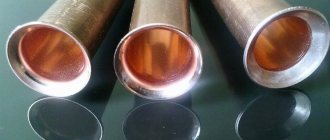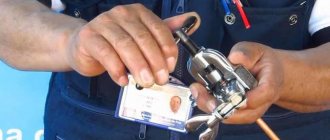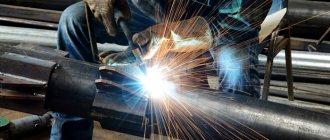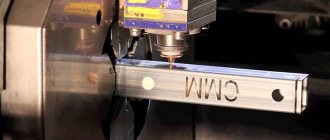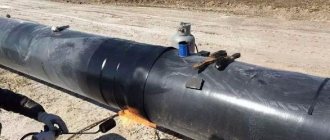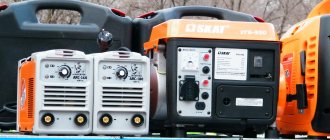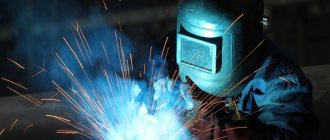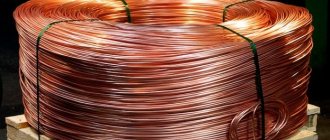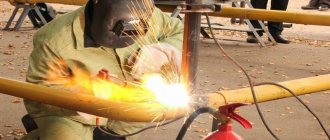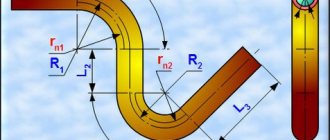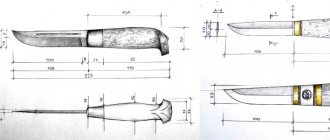Pipe flaring: subtleties of technology and basic tools
Specialists often have to change both the configuration and other geometric parameters of pipe rolling to solve various problems. Most often, to change the shape and size of a tubular product, a technological operation such as flaring is used. It should be borne in mind that this operation is fundamentally different from what is called rolling, and these differences are significant.
The ends of these copper pipes are flared: expanded to a specific shape and prepared for connection
Overview of species
There are several main types of flaring.
Single
The single type is the simplest of all existing ones. This method is rarely used, since it is characterized by low quality and insufficiently strong pipe connections. Single flaring is done at an angle of 45 degrees, looks like a single funnel, and is performed using any hand-held device.
"Under the fungus"
This is a one-time flaring. It requires a special eccentric. Although such flaring is considered one-time, in practice the tube can be screwed on several times, and the quality of the connection does not suffer - this has been repeatedly tested in practice.
Double
Double funnel is an American standard. With this treatment, pipes can be connected multiple times. To achieve this result, two operations must be performed. The first result is a “bubble” in the form of a frame.
During the second operation, the cone jams and a funnel is formed.
Double sided
This flaring looks like a single funnel with a double edge. This result can be achieved by using a professional tool that comes with a set of attachments.
Flaring and Rolling
First of all, it should be understood that pipe flaring cannot be called rolling, since the essence of these technological operations is completely different.
- Rolling, for which a special rolling machine is used (a machine equipped with work rolls), is a technological operation during which rolled sheet metal or a metal pipe is deformed in the radial direction. Using this operation, in particular, products of cylindrical or conical shape are formed from sheet metal, and products with a different cross-sectional shape are also made from round rolled pipes.
- The flaring tool does not contain work rolls in its design, and the essence of the procedure itself is that only the end of the pipe is subjected to plastic deformation, while its internal and external diameters increase to the required parameters. The need to perform such an operation most often arises in cases where two sections of pipe need to be securely connected to each other.
Types of tube flaring
To obtain a reliable and tight connection between two pipes, various methods are used - soldering, the use of union couplings and other fitting elements, etc. In some of these cases (particularly when soldering and using slip-on couplings), the ends of the tubular products need to be widened. To perform this procedure, a flaring machine is required.
Many home craftsmen also mean by flaring other technological operations, the purpose of which is also the plastic deformation of a separate section of a pipe product. This includes, for example, rolling and bending.
- Rolling is a procedure that does not imply expansion, but narrowing of the edge of the pipe. In this case, a simple crimping method is used, for which ordinary pliers or miniature rollers are used. The need to perform such an operation arises in cases where it is necessary to cut a thread at the end of a pipe using a hand tool.
- Bending is a technological operation for which special devices with working rollers are used and which is often also called flaring, although this is fundamentally incorrect. The purpose of bending, which can be applied to both soft copper tubes and rolled pipes made of steel and other metals, is not to expand, but to bend a separate part of the product at the required angle.
Thus, rolling and flaring should be understood as completely different technological operations.
Flaring tubes during air conditioner installation
What is flaring
Flaring refers to the process of obtaining a conical skirt at the end of a pipe. The diameter of such a formation exceeds the diameter of the starting material. This is possible due to the stretching of the metal. The larger the cross-section of the flared section, the smaller the thickness of its wall. Any pipes made of soft material (aluminum, copper, their alloys, some brands of stainless steel) can be flared manually. The hard metal is machined. Flaring should not be confused with pipe rolling.
How to flare a pipe
When wondering how to flare a pipe, you should keep in mind that only products made from a sufficiently plastic material can undergo such a procedure. This, in particular, includes soft tubes made of copper and aluminum alloys, as well as certain grades of stainless steel. To perform such a technological operation, either a commercially produced flaring machine or a home-made device can be used. Meanwhile, flaring of large-diameter steel pipes or products made of other metals must be carried out using professional equipment.
Pipe flaring device
How to flare pipes at home? In such situations, tubes made of copper and other soft metals are most often subjected to flaring, but regardless of the material used to make the products, this technological operation is performed in the following sequence:
- The end of the pipe is thoroughly cleaned, and burrs are removed from its surface.
- Then a special coupling is installed on it and placed in a flaring device.
- If a manual flaring machine is used to perform flaring, then the process of doing it is as follows: when screwing in the screw, the cone of the flaring device, exerting a mechanical effect on the inner surface of the pipe, deforms it.
- Once the end of the tube has taken a funnel shape with a bevel angle of approximately 45°, the flaring tool is removed.
- The detachable coupling, which was previously put on the tube, is moved to its end and the nut is tightened.
If the flaring machine is used to prepare tubes for soldering, a threaded detachable coupling is not used.
Fastening metal-plastic pipes to the surface
When working with metal-plastic pipes, you need to know how to mount them to the surface. To secure the pipes you must use special clips. They are selected taking into account the size of the pipe itself. First you need to install the clip. Its fastening is carried out using self-tapping screws or dowels. To avoid sagging of the line, the distance between adjacent clips should not exceed one meter. Pipe bends must be secured on both sides.
To avoid sagging of the pipeline, the distance between adjacent clips should not exceed 1 meter. The turn of the highway in the corner of the room must be fixed on both sides
Tools and accessories
For flaring tubes, depending on the material they are made of, various devices can be used. If you need a flaring machine for processing copper tubes, then a homemade device for flaring tubes is quite suitable for this.
In the case of flaring copper tubes with your own hands, it is not so much force that is required as accuracy. The funnel formed during this procedure at the end of the copper pipe must be free of defects, distortions and chips.
Types of manual flaring devices
To perform flaring, a hand-made tool can also be used. We list the devices most often required in such cases:
- a device whose design consists of two parts - a clamp, which ensures the retention of a tube of a certain diameter, as well as a cone connected to a screw (the clamp is a metal plate in which holes of various diameters are made);
- An extender is a lever-type device, the working body of which is an adjustable expansion head for processing pipes of various diameters (the adjustable legs of such a device, which is fixed in a certain position, act on the inner walls of the pipe, stretching them).
Drawing of a homemade device for flaring tubes (click to enlarge)
The manual flaring tool should be used as carefully as possible, otherwise the pipe being processed may develop walls of varying thickness.
Stages
To better understand flaring technology, it will be useful to consider the main stages of this process.
- Careful trimming, the result of which should be a right angle between the end and the plane. The fewer deviations there are in this indicator, the better the result will be.
- Cleaning metal, removing burrs, oxides and other defects.
- Putting a threaded coupling on the pipe.
- Clamping the workpiece in the bed. In this case, a few millimeters of a round workpiece are left above the bed - this will be the working area.
- When screwing in the screw element, the flaring cone must rest against the end with such force that the resulting pressure is sufficient to deform the pipe. The result of this impact will be the formation of a “skirt” with a bevel of 45 degrees.
- The pipe can be removed from the frame, and the coupling moves to the machined edge.
- To facilitate pipe processing, a lubricant is used. The screw is moved back and forth until the desired result is achieved.
When working with a hand tool, the operating principle changes slightly.
- The workpiece is pushed onto the head with a suitable diameter until it stops.
- The stationary handle is held, and the movable handle moves around the circle. With this effect, the sponge heads will gradually spread apart. There is no need to use excessive force, since the workpiece can be torn.
- When the diameter has been expanded to the desired value, you can remove the pipe being processed and check the result.
When is flaring required?
If there is poor transmission of fluid through the pipes, the car brakes late, and the braking distance almost doubles. Also during the operation of the system, especially noticeable when the brake pedal is pressed, extraneous sounds appear, as well as some pulsating movements. The movement of the pedal, while pressing it, will seem a little free to you, this is very typical when the brake system, namely the brake pipes and hoses, is not functioning properly.
The most obvious symptom that the tubes are starting to wear out or have already worn out and it’s time to do flaring is an increase in braking distance.
It is important to know that the main problems due to which tubes break quite often are:
- destruction of the hexagonal head structure;
- the ingress of debris and dirt into the threaded connections or the ingress and coking of liquid in these places.
The above mentioned troubles cause great harm not only to the elements, but to the entire system. If the owner wants to protect the car from this kind of trouble, he should remember that it is necessary to test the car’s brake system at least once a year. If we equate the elements and the system itself with mileage, then diagnostics must be carried out every 50,000 kilometers, and parts, in particular rubber tubes, are changed after 125 thousand kilometers, regardless of their technical condition.
Where should I start installing a water supply system?
It is best to start installing metal-plastic pipes by drawing up a plan and calculating the required material. You should immediately determine what type of fittings you need to purchase, how many fasteners to buy for installing the pipe, etc. For greater convenience, you can draw up on paper a diagram of the premises where the water supply system will be installed. These are the toilet, bathroom and kitchen. It is worth noting that there is a double water supply to the faucets, separate for hot and cold water, and exclusively cold water is supplied to the washing machine, dishwasher and toilet. Then you need to measure the exact length of the future water supply structure, which allows you to carefully consider the number of necessary elements. If people with experience help you with this, it will only be better.
Installation of a metal-plastic pipe begins with the installation of ball valves (valves). To perform such work, it is better to order the services of a professional plumber. He will be able to turn off the water, install valves and make the first part of the connection, after which you can install the water supply in the apartment yourself. The services of a specialist are necessary here, because the installation of ball valves is carried out using a soldering or welding machine by qualified plumbers.
Instructions for self-flaring
Not every motorist has the desire to do repairs. For some, this is too difficult an activity, while others do not have the time or desire. If you consider yourself to be in the listed categories, then you can always contact a car service center and entrust the flaring to professionals.
There is another factor that can stop you - the lack of a special tool. However, it can always be purchased at a car store or ordered online. The tool works with metal as carefully as possible, while maintaining uniform wall thickness and smoothness of the inner surface.
Conclusion
We have looked at how copper pipes are flared for connection using a coupling or soldering. To do this, it is important to choose the right tool and follow the instructions provided. As a result, you will have a reliable and sealed pipeline. (See also the article Fittings for sewer pipes: features.)
Rolled copper pipeline
The video in this article will provide you with additional information. Happy installation!
Previous post Ductile iron pipes: description, features, regulatory documentation, areas of application
Next entry BNT pipe: features and scope
The use of tubes in the design of vehicles
Modern machines use several hydraulic systems with different main lines. One of them is the braking system. The working fluid moving through it must be isolated from the external environment due to tightness.
You need to know that thanks to good connections at the joints of the pipes, it is possible to achieve a high degree of tightness for the vehicle’s vehicle.
The success of reliable connections depends on the quality of the flaring. This operation uniformly increases the diameter of one tube tip. At the counter tube, the diameter of the tip is reduced to ensure rolling (entering a small diameter into a larger one and holding the pair in this position for a long time).
If the tubes in any of the sections receive mechanical damage, then due to depressurization of the system, part of the main wiring must be replaced. At a car factory, flaring is done using special equipment that contains hydraulic, electrical and mechanical drives. In garage conditions, a device for flaring brake pipes is most often mechanically driven by the muscular strength of the performer.
Recommendations for implementation
Even if you have never dealt with the flaring process before, you can get a good result the first time. Advice and recommendations from experts will help with this.
- Pipes must be carefully checked before work. Their cross-section should be perfectly round, without burrs, debris or other defects.
- During processing, distortion of the workpieces and the expanding tip must not be allowed. Otherwise, the socket will be asymmetrical, and a reliable connection will no longer be possible.
- In the case of manual processing, the blank is not pressed in, but screwed in. In this case, the force will be evenly distributed and the likelihood of pipe damage will be reduced.
- If the work is performed with an expander, the pipe processing is divided into several stages. Stretching the pipe should be done after the edge has been slightly expanded.
- When using machines with dies, you need to clearly select the hole to match the diameter of the workpiece - the error here should be minimal.
- The outside of the pipe is treated with an abrasive sponge, which will remove dust and other contaminants. If you skip this step, you may encounter the workpiece slipping in the matrix, which will greatly complicate the work.
For an overview of pipe flaring tools, see below.
Source
Purpose of brake pipes
In order to have a clear picture of what brake pipes are needed for and what role they play, you do not need to consider them as a separate element, you need to become familiar with the entire braking system of the car. Thus, having understood the operation of the system as a whole, the task of the tubes will be clear. The braking system, superficially, works in this way: if it is necessary to slow down or brake sharply, the driver presses the corresponding pedal, and the piston located in the master cylinder, under high pressure, begins to drive fluid along special paths.
Braking itself or a complete stop of the car occurs at the moment, at the moment of converting the forces of fluid pressure on the wheel cylinders into the resistance of the brake pads. So, the paths along which the piston drives fluid to the wheels consist of brake pipes and hoses. Failure of any part of the system results in a breakdown of the entire braking system, and consequently, your car becomes unusable.
Preventing brake pipe breakage
Naturally, in order not to waste a lot of time in the future searching for breakdowns and repairs, it is best to treat your vehicle with care. Don't be lazy, just follow these simple tips:
- Periodically inspect the brake lines for rust and defects. Contamination, microcracks, and corrosion lead to incorrect operation of the system.
- Change the brake fluid according to the regulations.
- Check the tightness of the fasteners.
- Treat surfaces with anti-corrosion agents.
- Avoid leaking brake fluid.
- Become an advocate for careful driving. It is not uncommon for tubes to rupture when overcoming obstacles.
- Have your brakes inspected at least once every two years. Motorists who spend a lot of time on the road should do this after every fifty thousand miles.
- Regularly monitor the wear and tear of vehicle parts, and it will take care of your safety.
When is flaring required?
If there is poor transmission of fluid through the pipes, the car brakes late, and the braking distance almost doubles. Also during the operation of the system, especially noticeable when the brake pedal is pressed, extraneous sounds appear, as well as some pulsating movements. The movement of the pedal, while pressing it, will seem a little free to you, this is very typical when the brake system, namely the brake pipes and hoses, is not functioning properly.
The most obvious symptom that the tubes are starting to wear out or have already worn out and it’s time to do flaring is an increase in braking distance.
It is important to know that the main problems due to which tubes break quite often are:
- destruction of the hexagonal head structure;
- the ingress of debris and dirt into the threaded connections or the ingress and coking of liquid in these places.
Non-ferrous metal tubes in vehicle systems
We won’t touch the radiators for now, this is a separate topic. Let's take an interest in the pipes that are responsible for the operation of the car's brake and fuel systems. Rotten brake pipes are a problem not only of old Soviet cars, but also of newer foreign cars that have been driving on roads generously sprinkled with salt and all sorts of chemicals for several years. Tubes become unusable primarily due to the fact that they are affected by an aggressive chemical environment. In winter, we have plenty of this environment under our wheels. With human-made road surfaces, the salt comes off the roads along with the snow, but with our roads, it can remain there until next winter.
Instructions for self-flaring
Not every motorist has the desire to do repairs. For some, this is too difficult an activity, while others do not have the time or desire. If you consider yourself to be in the listed categories, then you can always contact a car service center and entrust the flaring to professionals.
There is another factor that can stop you - the lack of a special tool. However, it can always be purchased at a car store or ordered online. The tool works with metal as carefully as possible, while maintaining uniform wall thickness and smoothness of the inner surface.
If desired, you can easily purchase a flaring kit. In addition to the “flaring machine,” this includes:
- pipe cutter;
- mites;
- clamp;
- union;
- stamps for different tube diameters.
Important! Don't rush to buy the cheapest sets. Mostly they are of poor quality. It's better to pay a little more, but the tools will last longer.
If the listed obstacles do not scare you, and you have everything you need at hand, do the repairs yourself. The process of flaring brake pipes is not labor-intensive and will not take much time. At the same time, after successfully completed work, you will definitely feel a sense of pride in your own capabilities.
Follow the instructions carefully:
- Drive the car into a viewing hole or overpass and immobilize it.
- Get your flaring kit ready, and you'll also need a drill and some gasoline.
- Unscrew the brake pipe from the caliper or brake cylinder. Assess the extent of damage and the possibility of repair.
- If you can remove the damaged piece while still maintaining the desired length, cut it with a pipe cutter and discard it. He has already done his part.
- Treat the intact cut edge with gasoline.
- Use pliers to clamp the tube to create a connector for the fitting.
- Using a drill and a drill of the required diameter, chamfer the edges of the tube.
- Clean the tube from shavings and insert the fitting.
- Take the flaring tool and insert the tube into the desired hole. It is necessary that its end protrudes 5-6 mm beyond the edge.
- Clamp the tool. At this time, the mechanism processes the required part.
- Admire the result of the work. At the end of the tube there should be a neat expansion that will tightly connect the elements of the system.
- Reinstall all parts. Fill the brake fluid and bleed the system to remove all the air. Test the car's operation.
The use of tubes in the design of vehicles
Modern machines use several hydraulic systems with different main lines. One of them is the braking system. The working fluid moving through it must be isolated from the external environment due to tightness.
You need to know that thanks to good connections at the joints of the pipes, it is possible to achieve a high degree of tightness for the vehicle’s vehicle.
The success of reliable connections depends on the quality of the flaring. This operation uniformly increases the diameter of one tube tip. At the counter tube, the diameter of the tip is reduced to ensure rolling (entering a small diameter into a larger one and holding the pair in this position for a long time).
If the tubes in any of the sections receive mechanical damage, then due to depressurization of the system, part of the main wiring must be replaced. At a car factory, flaring is done using special equipment that contains hydraulic, electrical and mechanical drives. In garage conditions, a device for flaring brake pipes is most often mechanically driven by the muscular strength of the performer.
Purpose of brake pipes
In order to have a clear picture of what brake pipes are needed for and what role they play, you do not need to consider them as a separate element, you need to become familiar with the entire braking system of the car. Thus, having understood the operation of the system as a whole, the task of the tubes will be clear. The braking system, superficially, works in this way: if it is necessary to slow down or brake sharply, the driver presses the corresponding pedal, and the piston located in the master cylinder, under high pressure, begins to drive fluid along special paths.
Braking itself or a complete stop of the car occurs at the moment, at the moment of converting the forces of fluid pressure on the wheel cylinders into the resistance of the brake pads. So, the paths along which the piston drives fluid to the wheels consist of brake pipes and hoses. Failure of any part of the system results in a breakdown of the entire braking system, and consequently, your car becomes unusable.
Preventing brake pipe breakage
Naturally, in order not to waste a lot of time in the future searching for breakdowns and repairs, it is best to treat your vehicle with care. Don't be lazy, just follow these simple tips:
- Periodically inspect the brake lines for rust and defects. Contamination, microcracks, and corrosion lead to incorrect operation of the system.
- Change the brake fluid according to the regulations.
- Check the tightness of the fasteners.
- Treat surfaces with anti-corrosion agents.
- Avoid leaking brake fluid.
- Become an advocate for careful driving. It is not uncommon for tubes to rupture when overcoming obstacles.
- Have your brakes inspected at least once every two years. Motorists who spend a lot of time on the road should do this after every fifty thousand miles.
- Regularly monitor the wear and tear of vehicle parts, and it will take care of your safety.
